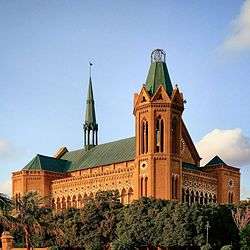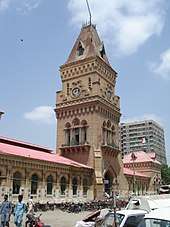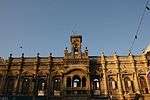Saddar Town
| Saddar Town صدر | |
|---|---|
| Municipality | |
 Karachi's colonial era Frere Hall is located in Saddar. | |
| Country | Pakistan |
| Province | Sindh |
| City District | Karachi |
| Established | 14 August 1947 |
| Union Councils | |
| Government | |
| • Type | Town Council |
| • Town Nazim | Muhammad Dilawar |
| • Naib Nazim | Nasir Khan Taimori |
| • Municipal Officer | Mukhtar Hussain |
| Population (1998) | |
| • Total | 616,151 |
| Website | Saddar Town Page |
Saddar Town (Sindhi: صدر ٽائون; Urdu: صدر ٹاؤن), is a town in the central part of Karachi, Pakistan, that forms much of the historic colonial core of the city. Saddar Town contains the largest concentration of British colonial architecture in Karachi.[1][2][3]
Etymology
The word Saddar generally means the "centre" (of a settlement) and also "head" (of a group of people or an organisation).
Location
Saddar is located in the colonial heart of Karachi. It is bordered by Jamshed Town and Clifton Cantonment to the east, Kiamari Town and the Arabian Sea to the south and Lyari Town to the west. The majority of the population are Gujarati and Sindhi Muslims. Among the Gujarati-speaking people are trading communities such as Memons and Marwaris.[1]
History

Saddar Town contains much of the oldest parts of Karachi, in particular the neighbourhoods of Kharadar and Mithadar which represent the pre-colonial history of Karachi. The above names mean Salty Gate and Sweet Gate respectively and refer to the two main gates of the old walled town of Karachi that were built in 1792 and stood on the sites of the two modern neighbourhoods. The Salty Gate opened towards the Arabian Sea (hence the word "salty") and the Sweet Gate opened towards the Lyari River (hence the word "sweet"). Both gates were dismantled by the British around 1860.
During the colonial era, Saddar was the centre of Karachi, a status maintained from 1947 to the 1960s, when the federal government offices were based in Saddar.[1] They have now been replaced by the offices of the provincial Government of Sindh. Many beautiful examples of colonial architecture can be found in Saddar Town including the main building of Karachi Grammar School, Frere Hall and the Sindh Club.[3]
The federal government introduced local government reforms in the year 2000, which eliminated the previous third tier of government (administrative divisions) and raised the fourth tier (districts) to become the new third tier. The effect in Karachi was the dissolution of the former Karachi Division and the merger of its five districts to form a new Karachi City-District with eighteen autonomous constituent towns including Saddar Town.
Neighbourhoods
Saddar Town is the main business area of Karachi, with the central shopping area found in the historic Empress Market as well as the Central Bus Station and the Central Railway Station and the nearby Port of Karachi. The area has the largest local market of mobile phones, a market named Mobile Market, containing spare parts for a worldwide variety of mobile phones as well as selling and buying of them. A major bustling street in Saddar is named Zaibunnisa Street, after the influential author and journalist, Zaib-un-Nissa Hamidullah.[4] The neighbourhood of Clifton has a long sandy beach popular with both locals and tourists and includes several tiny islands offshore in Karachi Bay.
|
Gallery
 The Mohamedali building is located on Zaibunnisa Street.
The Mohamedali building is located on Zaibunnisa Street. Saddar's Dinshaw Dispensary was bestowed by Seth Edulji Dinshaw
Saddar's Dinshaw Dispensary was bestowed by Seth Edulji Dinshaw Saddar's St. Patrick's Cathedral is seat of the Roman Catholic Archdiocese of Karachi.
Saddar's St. Patrick's Cathedral is seat of the Roman Catholic Archdiocese of Karachi. The Kutchi Memon Mosque was built in Saddar, and is a major centre for Memons in the city.
The Kutchi Memon Mosque was built in Saddar, and is a major centre for Memons in the city. St. Andrew's Church in Saddar was built in 1868.
St. Andrew's Church in Saddar was built in 1868.
See also
References
- 1 2 3 4 5 6 7 "KARACHI: Saddar: the VIP town". Dawn (newspaper). 5 August 2005. Retrieved 7 April 2018.
- ↑ "Pakistan's crumbling architectural heritage - The Peninsula Qatar". www.thepeninsulaqatar.com. Retrieved 2018-03-09.
- 1 2 Faizah Malik (28 March 2018). "Heritage Foundation calls for restoration of Calcutta House in Karachi". The Express Tribune (newspaper). Retrieved 7 April 2018.
- ↑ Wandering in wonder: A new way to visit Karachi Dawn (newspaper), Published 19 January 2015, Retrieved 7 April 2018
External links
Coordinates: 24°51′27″N 67°00′10″E / 24.85750°N 67.00278°E